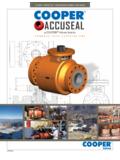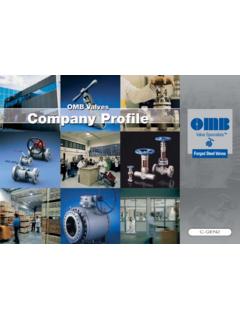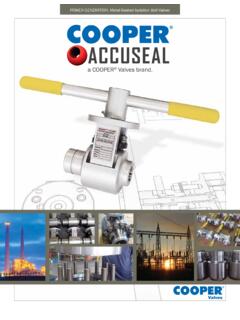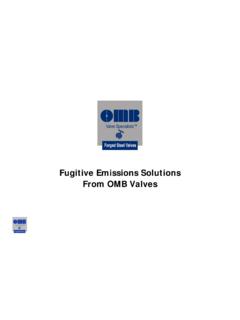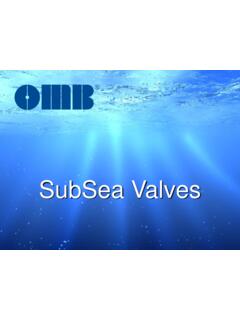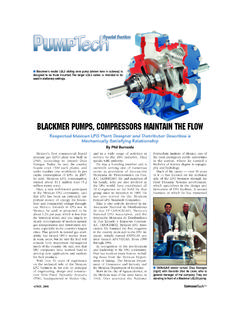Transcription of Demystifying Leakage Nomenclature - Triple M
1 | + | your time working in the valve industry you will hear various forms of Nomenclature thrown around when talking about valve Leakage testing or fugitive emissions testing. An example would be Class VI Zero Leakage . While this doesn t really mean a true 0% Leakage rate, it does mean that it complies with the ANSI/FCI 70-2 acceptable Leakage rate for Class VI. This document will hope-fully help give you a better understanding of what types of testing there are as well as what they are applied I Valve Leakage In Class I Valve Leakage there is no shop test done on the valve to determine Leakage rates. This class is considered dust tight .Class II Valve Leakage This classification is intended for double port or balanced single port valve using a metal piston ring seal and metal to metal seats. The testing parameters allow for Leakage when the valve is in the full open position. The test is completed using air at 45-60 III Valve Leakage This classification is intended for the same valves in Class II but only allows for Leakage when fully open.
2 The test itself is the same with air at 45-60 psigClass IV Valve Leakage This classification is intended for single port and balanced single port valves with extra tight piston seals and metal to metal seats. Acceptable Leakage drops significantly to The testing criteria is the same at 45-60 V Valve Leakage Used on the same valves as Class IV, but the testing medium is changed to water at 100 psig. Leakage is acceptable up to 5x10-4 ml per minute per inch of orifice diam-eter per psi VI Valve Leakage This class establishes the maximum allowed seat Leakage normally associated with resilient seated valves either unbalanced or balanced single-seat O rings or similar gapless seals. Testing is done with air or nitrogen gas at 10-52 C (50-125 F) at the maximum rated dif-ferential pressure across the valve plug or bar (50 psig) whichever is least. Allowable Leakage is per FCI 70-2 Table (mm.)
3 NPS(in.)ml per Min-uteBubbles per Minute* 25 1** ** 70-2 - Table 2*Bubbles per minute as tabulated are a suggested alternative based on a suitable calibrated measuring device, in this case, a 6 mm ( inch) x 1 mm ( inch) wall tube submerged in water to a depth of from 3 to 6 mm ( to inch). The tube end shall be cut square and smooth with no chamfers or burrs and the tube axis shall be perpendicular to the surface of the water. Other apparatus may be constructed and the number of bubbles per minute may differ from those shown as long as they correctly indicate the flow in ml per minute.**If the valve seat diameter differs by more than 2 mm ( inch) from one of the values listed, the Leakage rate may be obtained by interpolation assuming that the Leakage rate varies as the square of the seat 70-2 For control valve seat Leakage there is ANSI/FCI 70-2 which deals with Class I, II, III, IV, V, and VI ac-ceptable Leakage rates.
4 The individual classes determine what type of test is done and what the ac-ceptable seat Leakage rate is. Class IV generally refers to metal-seated valves while Class VI refers to resilient or soft-seated valves. Our Accuseal ball valves, while metal-seated, actually meet the testing requirements for Class VI which is a more stringent requirement that normally only resilient seated valves can Leakage | + | 598 Summarized:What is Tested: Valve DesignMechanical Cycles: 310 Test Fluid: Methane Gas (97% Purity)Temperature: 260 C 2% (500 F 5%)Option Low Temperature: -29 C (-20 F)Thermal Cycles: 3 Pressure: 4,137 kPag (600 PSIG)Measurement: SnifferTo Pass:Emission less than 100 ppmValve SizeAll Re-silient Seated ValvesMetal Seated Valves Except CheckMetal Seated Check ValvesDN(mm)NPS(in.)Liquid Test a(drops/minute)Gas Test(bub-bles/minute)Liquid Te s t(cc/min)Gas Test(m3/h)Gas Test(ft3/h) 50 200b0b6 598 - Table 6 API 598 When isolation and/or absolute tight shut-off is required, API 598 is the recom-mended standard over ANSI/FCI 70-2.
5 For on/off valves, or our gate, globe, and check product lines, we test to API 598. This testing specification refers to the allowable fugitive emissions from the shell, backseat, and closure. The allow-able Leakage rate varies based on the valve size. Testing can be completed using either liquid or gas with specific Leakage tolerances for each. The shell, backseat, and closure are the three parts tested and have individual acceptable leak rates which can be found in Table 6 of API For the liquid test, 1 mL is considered equivalent to 16 shall be no Leakage for the minimum specified test duration. For liquid test, 0 drops means no visible Leakage per minimum specified test duration. For gas test, 0 bubbles means less than 1 bubble per minimum specified test Leakage | + | 622 Summarized:What is Tested: PackingMechanical Cycles: 1,510 Rate: 10 to 15 per secondRotation: 90 5 Test Fluid: Methane Gas (97% Purity)Temperature: Ambient to 260 C (500 F)Thermal Cycles: 5 Pressure: 0 to 4,137 kPag (0 to 600 PSIG)Measurement: SnifferTo Pass:Weight loss less than 15%Emission less than 500 ppmAPI 624 Summarized:What is Tested: Valve DesignMechanical Cycles: 310 Test Fluid: Methane Gas (97% Purity)Temperature: 260 C 2% (500 F 5%)Option Low Temperature: -29 C (-20 F)Thermal Cycles: 3 Pressure: 4,137 kPag (600 PSIG)Measurement: SnifferTo Pass:Emission less than 100 ppmAPI 624 API 624 applies to rising stem valves with flexible graphite packing that have API 622 qualified pack-ing.
6 The acceptable fugitive emissions for this test are 100 ppm. The test is conductive with a ran-domly selected valve as opposed to a text fixture while using methane gas with a minimum purity of 97% as the test fluid. The valve is mechanically cycled 310 times in order to complete the test. As of this writing, API 624 is still awaiting final review from the 622 Packing fugitive emission testing has two standards, API 622 and the upcoming API 624. Both meth-ods are EPA Method 21 compliant. API 622 applies to packing only. The test method requires actu-ated stroking within a text fixture for 1,510 mechanical cycles with 97% minimum purity dry methane test fluid. The graphite packing is measured after the test is complete to determine its resistance to oxidation. If it loses more than 15% of its weight or exceeds 500 ppm, the test is a Leakage Nomenclatur
